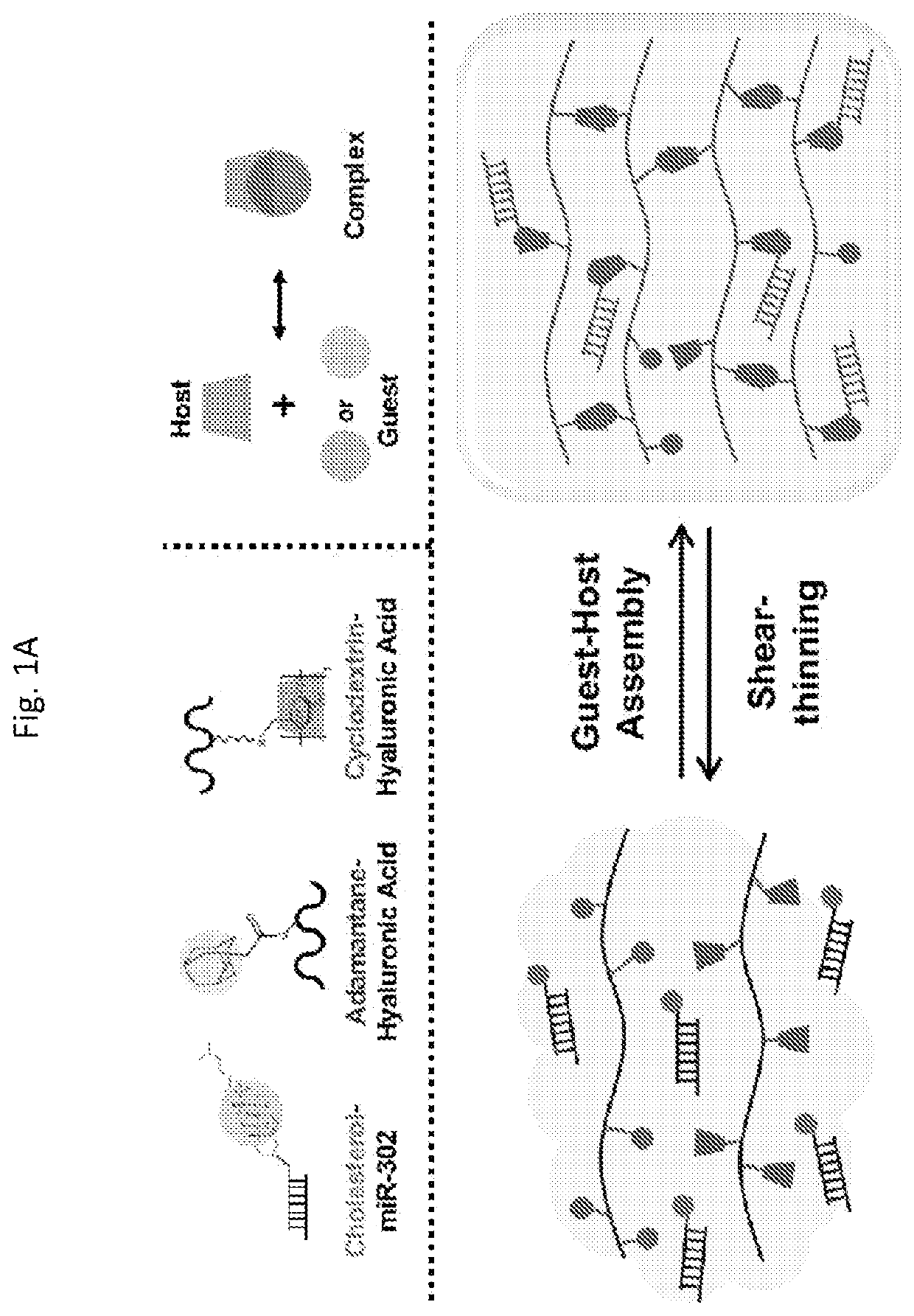Compositions and methods for cardiac regeneration
a technology of compositions and cardiac regeneration, applied in the direction of cardiovascular disorders, drug compositions, aerosol delivery, etc., can solve the problems of 50 % mortality at five years, heart tissue damage, and public health issues
- Summary
- Abstract
- Description
- Claims
- Application Information
AI Technical Summary
Benefits of technology
Problems solved by technology
Method used
Image
Examples
example 1
Preparation and Loading Guest-Host Hydrogel
[0068]Material Synthesis: Sodium hyaluronate (LifeCore, Chaska, MN) was converted to a tetrabutylammonium salt (HA-TB A) by exchange against Dowex-100 resin and neutralization by tetrabutylammonium hydroxide. CD-HA and AD-HA were synthesized as previously described. Briefly, CD-HA was prepared by amidation between 6-(6-aminohexyl)amino-6-deoxy-β-cyclodextrin and HA-TBA in the presence of benzotriazol-1-yloxy) tris(dimethylamino)pho sphoniumhexafluoropho sphate (BOP). AD-HA was synthesized by esterification of HA-TBA with 1-adamantane acetic acid in di-tert-butyl bicarbonate (BOC2O) and 4-dimethylaminopyridine (DMAP). Products were dialyzed, frozen and lyophilized prior to use. 1H NMR (Bruker) at 360MHz was used to determine final product modification, which was approximately 25% of HA disaccharide repeats for both CD-HA and AD-HA.
[0069]miRNA molecules used had the following sequences:
cel-miR-67 (miR-NC)(Guide; SEQ ID NO: 14)5′-CGCUCAUUCUGCC...
example 2
[0070]To further examine the interaction between cholesterol and CD, we developed a fluorometric binding assay to measure the interaction between cholesterol-modified miR302b / c and CD-HA. This assay is based on the ability for cholesterol to bind to and displace Rhodamine B from β-cyclodextrin, leading to unquenching and increased fluorescence. Gels were prepared as described in Example 1. Rhodamine B (50 ng / μL) was mixed with varying amounts of CD-HA (0-50 ng / μL) towards a final concentration of 200 μL in DI H2O to determine saturating concentrations for quenching. For unquenching assays, Rhodamine B (50 ng / μL) was mixed with miR-302 mimics (0-5 μM) in a final volume of 200 μL. Emission was measured from 530 to 580 nm on a Tecan Infinite200 plate reader at an excitation of 550 nm. miR-302b-chol affinity for Rho / CD-HA complexes was calculated by fit to the Benesi-Hildebrand equation.
[0071]We found that cholesterol-modified miR-302 mimics bound to CD-HA in a ...
example 3
Rheological Characterization
[0072]To confirm that cholesterol-modified miR-302b and miR-302c mimics, hereafter termed miR-302, did not affect mechanical and erosive behaviors of hydrogels, we performed oscillatory rheology and hydrogel erosions assays.
[0073]Measurements were performed using an AR2000 stress-controlled rheometer (TA Instruments) fitted with a 20 mm diameter cone and plate geometry, 59 min 42 s cone angle, and 27 μm gap. Rheological properties were examined by time sweeps (1.0 Hz; 0.5% strain). For shear recovery experiments, shear-thinning was performed at 250% strain with recovery at 0.5% strain, each at 20 Hz.
[0074]Gel erosion at two weeks was also not affected by inclusion of miR-302 in the system from a uronic acid assay measuring total hyaluronic acid degradation (FIG. 1E).
PUM
| Property | Measurement | Unit |
|---|---|---|
| δ | aaaaa | aaaaa |
| wt % | aaaaa | aaaaa |
| volume | aaaaa | aaaaa |
Abstract
Description
Claims
Application Information
 Login to View More
Login to View More - Generate Ideas
- Intellectual Property
- Life Sciences
- Materials
- Tech Scout
- Unparalleled Data Quality
- Higher Quality Content
- 60% Fewer Hallucinations
Browse by: Latest US Patents, China's latest patents, Technical Efficacy Thesaurus, Application Domain, Technology Topic, Popular Technical Reports.
© 2025 PatSnap. All rights reserved.Legal|Privacy policy|Modern Slavery Act Transparency Statement|Sitemap|About US| Contact US: help@patsnap.com



